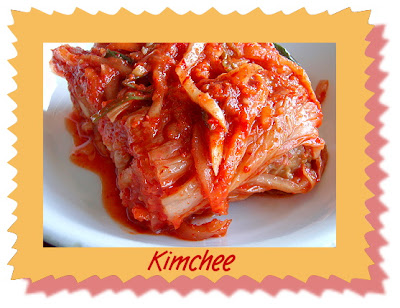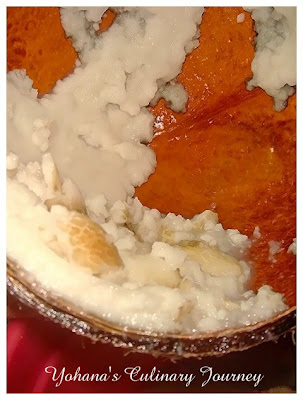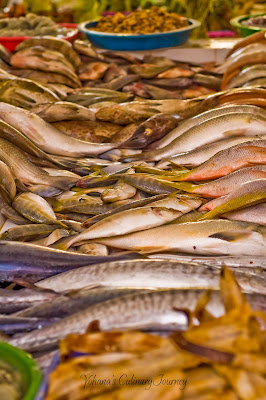Kimchee
On my entry at my other blog, I mention that I had the chance to asked a Korean mom at my son school on where to buy some Korean ingredients and she kindly gave me the ingredients for free and even her home-made kimchee too. So now I feel obligated to really try to make kimchee for the first time.
All this time I thought making kimchee is hard but actually it is not. It is because the whole proces is being stretch into 3 intervals. The first being preparing the cabbage by salting it first. Then the seasoning part and then the waiting period which can be varied from 5 days to 3 weeks!
In my library, I have about 5 books that contain recipe for making authentic kimchee. I don't know which one is best yet but after reading them, I choose this one because it is the easiest. Well... what do you expect. I like easy but tasty recipe!
Here is the recipe that I use ...

Kimchee
Ingredients:
3 heads Chinese cabbages ( 22 1/4 lbs, 10 kg )
14 oz ( 400g ) salt -- 4 % weight of cabbage
21 oz ( 600g ) daikon radish
1/5 oz ( 6 g ) salt ( 1 % weight of radish )
Marinade A:
1 1/3 cups dashi stock
2 Tbs flour ( I use 3 Tbs of rice flour )
2 Tbs salted opossum shrimp
2 Tbs anchovy suace
Marinade B :
2 bunches chives ( 1 3/4 oz, 50g ), cut into 1 1/2 in ( 4 cm ) length
7 oz ( 200g ) finely chopped green onion
5 1/4 oz ( 150g ) ground chili pepper
3 1/2 oz ( 100g ) sugar ( I use more, close to 200gr of sugar )
1 3/4 oz ( 50g ) grated ginger root
2 Tbs crushed garlic ( I use more, I use one whole bulb of garlic )
MSG or dashi-no-moto ( instant stock ) -- I strongly suggest that you use both MSG and a bit of dashi-no-moto too.
NOTE: Success of kimchee depends on the salting process. Temperature, weight and pickling time ar ethe important elements. So do it throughly and be patient.
How To Make Kimchee:
The reason why I use more sugar is because of my taste preference is a bit sweeter, not to sour only. And the reason why I use 3 Tbs of rice flour is because on different recipe book, it calls mostly using rice flour and I like thicker sauce on my kimchee, not the runny type one. About the extra garlic that I use. Again, it is about taste.
The hardest part in term of finding the ingredients is the opposum shrimps. But I guarantee you, as long as you can find a Korean store nearby, you can find it because I don't think Koreans can live without eating their beloved kimchee on daily basis, hahaha... The salted opossum shrimps is 3/8 in ( 1cm) long, shrimp-like arthropod. It is salted and used as an essential ingredients of kimchee. When added to the salted vegetables in fermenting process, it producess, vitamin B12 and at the same time amino acid. So the sour taste that you get from eating kimchee DO NOT comes from vinegar. It comes from the fermentation that being generated by the opossum shrimp, remember that. So if people tell you that they can make authentic kimchee using vinegar, you can just forget about it. When you have difficulty to explain that you want to buy opossum shrimp to the store owner or store keeper ( I always have problem talking in English with them in the States , Canada even here too! ), you can just go straight to their freezer section and look for a bottle with this white looking shrimps. The other name of opossum shrimp is fermented shrimps . The Korean name is Saeujeot. Better write it down, it is too hard to remember I think ...
All this time I thought making kimchee is hard but actually it is not. It is because the whole proces is being stretch into 3 intervals. The first being preparing the cabbage by salting it first. Then the seasoning part and then the waiting period which can be varied from 5 days to 3 weeks!
In my library, I have about 5 books that contain recipe for making authentic kimchee. I don't know which one is best yet but after reading them, I choose this one because it is the easiest. Well... what do you expect. I like easy but tasty recipe!
Here is the recipe that I use ...

Kimchee
Ingredients:
3 heads Chinese cabbages ( 22 1/4 lbs, 10 kg )
14 oz ( 400g ) salt -- 4 % weight of cabbage
21 oz ( 600g ) daikon radish
1/5 oz ( 6 g ) salt ( 1 % weight of radish )
Marinade A:
1 1/3 cups dashi stock
2 Tbs flour ( I use 3 Tbs of rice flour )
2 Tbs salted opossum shrimp
2 Tbs anchovy suace
Marinade B :
2 bunches chives ( 1 3/4 oz, 50g ), cut into 1 1/2 in ( 4 cm ) length
7 oz ( 200g ) finely chopped green onion
5 1/4 oz ( 150g ) ground chili pepper
3 1/2 oz ( 100g ) sugar ( I use more, close to 200gr of sugar )
1 3/4 oz ( 50g ) grated ginger root
2 Tbs crushed garlic ( I use more, I use one whole bulb of garlic )
MSG or dashi-no-moto ( instant stock ) -- I strongly suggest that you use both MSG and a bit of dashi-no-moto too.
NOTE: Success of kimchee depends on the salting process. Temperature, weight and pickling time ar ethe important elements. So do it throughly and be patient.
How To Make Kimchee:
- Discard dead outer leaves. Cut in half.
- With the leaves still attached to the root, sprinkle some salt between leaves, heavily over root side.
- In a large container, place the cabbage, top with a light weight and let stand a whole day and night ( in summer time or in Surabaya's weather, over night is enough ), turning over several times for even salting. Rinse in water; drain and set aside 3- minutes. Peel daikon radish, shred and sprinkle with salt; squeeze out water gently.
- Prepare marinade . In a small pan heat (A) ingredients to boiling. Constantly stirring.
- Reduce heat to medium. Continue to cook stirring constantly to prevent burning. When forming a paste, remove from heat; cool. When completely cooled, add (B) and radish, mix.
- Between leaves, spread marinade paste. Grease you hand with sesame oil to prevent irritation caused by the chili pepper.
- Folding each section in two, pack in a container. Keep it in the fridge. Moisture comes out in 2 - 3 days, but do not take out at this point. Leave a further 7 days at least. Take out necessary amount, press down remainder to remove air.
The reason why I use more sugar is because of my taste preference is a bit sweeter, not to sour only. And the reason why I use 3 Tbs of rice flour is because on different recipe book, it calls mostly using rice flour and I like thicker sauce on my kimchee, not the runny type one. About the extra garlic that I use. Again, it is about taste.
The hardest part in term of finding the ingredients is the opposum shrimps. But I guarantee you, as long as you can find a Korean store nearby, you can find it because I don't think Koreans can live without eating their beloved kimchee on daily basis, hahaha... The salted opossum shrimps is 3/8 in ( 1cm) long, shrimp-like arthropod. It is salted and used as an essential ingredients of kimchee. When added to the salted vegetables in fermenting process, it producess, vitamin B12 and at the same time amino acid. So the sour taste that you get from eating kimchee DO NOT comes from vinegar. It comes from the fermentation that being generated by the opossum shrimp, remember that. So if people tell you that they can make authentic kimchee using vinegar, you can just forget about it. When you have difficulty to explain that you want to buy opossum shrimp to the store owner or store keeper ( I always have problem talking in English with them in the States , Canada even here too! ), you can just go straight to their freezer section and look for a bottle with this white looking shrimps. The other name of opossum shrimp is fermented shrimps . The Korean name is Saeujeot. Better write it down, it is too hard to remember I think ...


Comments